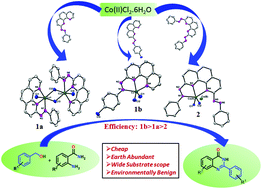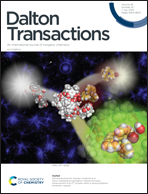Cobalt complexes of redox noninnocent azo-aromatic pincers. Isolation, characterization, and application as catalysts for the synthesis of quinazolin-4(3H)-ones†
Abstract
Herein we report the synthesis, characterization and catalytic application of three new cobalt(II)-complexes of redox noninnocent arylazo ligands, 2-(phenylazo)-1,10-phenanthroline (L1a), 2-(4-chlorophenylazo)-1,10-phenanthroline (L1b) and 2,9-bis(phenyldiazo)-1,10-phenanthroline (L2) respectively. The reaction of L1a with CoIICl2·6H2O produced a μ-dichloro bridged binuclear cobalt(II)-complex [CoII2(L1a)2Cl2] (1a) while the same reaction when carried out with 2-(4-chlorophenyl)azo-1,10-phenanthroline (L1b) and 2,9-bis(phenyldiazo)-1,10-phenanthroline (L2) ligands produced two new mononuclear five-coordinate cobalt(II)-complexes 1b and 2 respectively. In complex 1a and 1b, the ligands L1a and L1b are coordinated to the cobalt(II)-center in a tridentate mode utilizing all of its nitrogen donor sites while in complex 2 one of the azo-donor sites of the ligand L2 remain pendant. All these complexes were characterized using available spectroscopic techniques and DFT studies. We further explored the potential of these complexes as catalysts for the synthesis of pharmaceutically important organic compounds via the functionalization of alcohols. A variety of substituted quinazolin-4(3H)-ones were synthesized under aerobic conditions via the coupling of alcohols and 2-aminobenzamide using 1b as the catalyst. Mechanistic investigations revealed that both cobalt and the arylazo scaffold act synergistically during catalysis.



 Please wait while we load your content...
Please wait while we load your content...